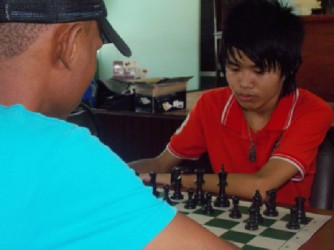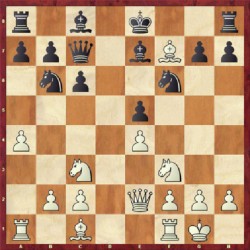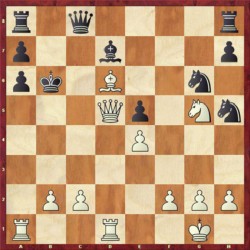The following game was played in 1965 between Dragoljub Velimirovic and Lubomir Kavalek in Belgrade. Kavalek recalled this game because the Bishop sacrifice which he encountered was identical to one which was played out between Wang Hao and Anish Giri at the Beijing 2013 FIDE Grand Prix. It was the identical Philidor system.
The beauty of the two games lies in the supporting moves which followed the sacrifices. The continuations were without flair. They were quiet, almost prophylactic, but gained momentum as the game progressed, and reached destructive force in the end.
Almost one hundred years ago German grandmaster Aron Nimzowitsch wrote a book, My System, in which he spoke of prophylaxis, pawn activity and the blockade. According to Mikhail Tal, this book is “full of the elixir of chess youth.’’ Many considered Nimzowitsch to be ahead of his time ‒ if there is something such as being ahead of your time. Both games are analysed by Kavalek. 

Velimirovic – Kavalek
Belgrade 1965
1.e4 d6 2.d4 Nf6 3.Nc3 e5 4.Nf3 Nbd7 5.Bc4 Be7 6.0-0 c6 7.a4 Qc7 8.Qe2 Nb6?! 9.dxe5 dxe5 10.Bxf7+!
[DIAGRAM 1] Kxf7 11.a5 Nbd7 12.Qc4+ Ke8
Black can’t allow a king hunt after 12…Kg6 13.Nh4+ Kh5 14.Qf7+ Kxh4 (14…g6 15.Nf5) 15.g3+ Kh3 16.Qe6+ Ng4 17.Ne2 Ndf6 18.Kh1 Bxe6 19.Ng1 mate.
13.Ng5 Nf8 14.Rd1 Bd7 15. Be3 Qc8
16.Qf7+ Kd8 17.Na4! c5 18.Nxc5! Bxc5 19.Qxg7 Ng6 20.Bxc5 Nh5 21. Be7+ Kc7 22. Bd6+ Kc6 23.Qf7 Kb5 24.a6 bxa6 25.Qd5+ Kb6 26.c4
Velimirovic prefers quiet moves. But he had a forced mate: 26.Rxa6+! Kxa6 27.Ra1+ Kb6 28.Qa5+ Kc6 29.Qc5+ Kb7 30.Qb4+ Kc6 31.Ra6+! Qxa6 32.Qc5+ Kb7 33.Qc7 mate.
26…Qc6 27.Qa5+ Kb7 28.Bc5 Rac8 29.b4 Rhd8 30. Nf7
30…Rg8 31.Rd6 Ngf4 32.Rxc6 Rxg2+ 33.Kf1 Rxc6 34.Nd8+ Kc8 35.Nxc6 Bxc6 36.Bd6 [Diagram II] Black resigned. 1-0.
Wang Hao – Anish Giri
Kavalek analyses the other Philidor defence game similar to the one played in 1965, between Wang Hao and the Dutch grandmaster Anish Giri at the 2013 FIDE Grand Prix in Beijing.
Wang Hao- Giri
FIDE GP Beijing 2013
1.d4 d6 2.e4 Nf6 3.Nc3 e5 4.Nf3 Nbd7 5.Bc4 exd4 6.Qxd4 Be7 7.Bxf7+!? [Diagram 1] Kxf7 8. Ng5+ Ke8
Other retreats are disastrous:
A. 8…Kg6 9.f4+-;
B. 8…Kg8 9.Qc4+ d5 10.Nxd5+-
9.Ne6 c5 10.Qd1 Qb6 11.Nxg7+ Kf7 12.Nf5 Bf8
After 12…Ne5 13.Nxe7 Kxe7 14.Bg5 Be6 15.f4 Nf7 16.Bxf6+ Kxf6 17.0-0 the black king is not secured
13.0-0 d5?! 14 . Nxd5 15 .Qxd5+ Ke8?
Allowing white to develop the rest of his pieces quickly. 15…Qe6 was logical, for example 16.Qd3 (16.Nh6+ Bxh6 17.Qxe6+ Kxe6 18.Bxh6 Nf6=) 16…Nf6 17.Re1 white has three pawns for a piece, but black is in the game.
16.Bg5 Qg6
Computer’s suggestion 16…Qc6 is also inadequate. White keeps the queens on the board
17.Qd2 with advantage.
17.Rad1 Rg8 18.f4 a5
19.e5 Qxf5 20.Qxg8 Ra6 21.Rfe1 Rg6
After 21…Re6 22.Rd6 Rg6 23.e6! white wins.
22.e6! [Diagram II] Chi 5.
After 22…Rxg8 23.exd7+ Kf7 24.d8Q wins.
Black Resigns. 1-0.









